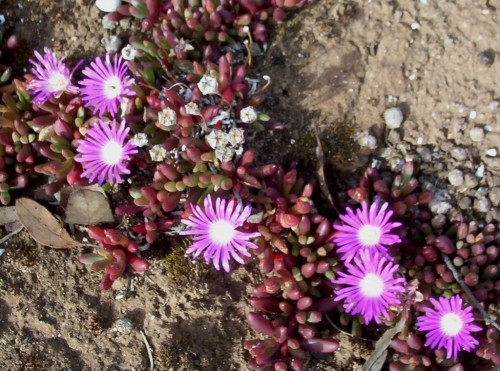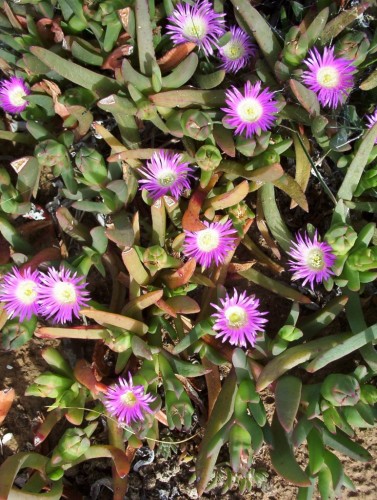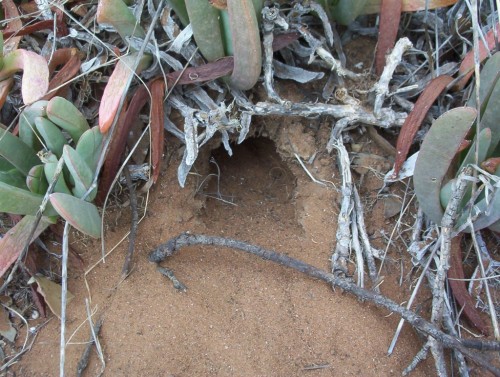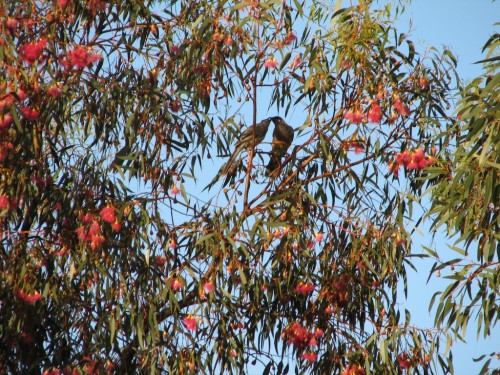Disphyma crassifolium (Rounded Noon-Flower)
The leaves seem to take on the reddish hew when it is in a dry position.
Carpobrotus rossii (Pig Face) In Flower
This is the flower of the succulent plant in the previous post. There were only a few isolated flowers on the plants near the nest. This is a useful plant. Not only is it useful and decorative in the garden, it is one of the bush tucker plants used by the local Aboriginal group. The leaves and fruits were used as a kind of relish to be eaten with meat. The juice from the leaves is also said to be an insect repellant. As with any new thing, a cautious test should be done before slathering one’s skin with the juice of an unknown plant.
I guess the same could be said for the plants in the Aloe family. Aloe Vera is good on a number of skin ailments but I am never sure which member of the species is the one to use.
Carpobrotus rossii (Pig Face, Karkalla)
Husband was checking out a pigeon’s nest in the corner of our block when a small bird seemed to fly from under his foot. Closer inspection revealed this little burrow at the base of the pig face, Carpobrotus rossii. The bird is the Spotted Pardalote. These and Rainbow Bee Eaters make burrows in sandy banks or cliff faces. During the spring and summer we often find scratchings that indicate the beginnings of burrows and it is quite exciting to actually have one being constructed on our place. Husband was able to get a photo of the bird carrying grass to the burrow to line it.
The nest is in the middle of the patch of this Pig Face. It is a very hardy plant like all succulents seem to be. I will be planting some of this on the edge of our driveway to create the illusion of ‘lawn’. There is no way that I could keep lawn going there and I wouldn’t want to anyway because it would be a waste of water.
Eucalyptus leucoxylon (South Australian Blue Gum)
This is one of those situations where one cannot use the common name for the species. Blue gum is the common name given to a few Eucalypts. The Tasmanian Blue Gum is Eucalyptus globulus. The Victorian Blue Gum is Eucalyptus globulus subspecies bicostata. The Sydney Blue Gum is Eucalyptus saligna.
This photo has Little Wattle Birds in the canopy of the tree. We were visiting a garden and sitting outside having a cuppa watching all this bird activity.
Rescuing More Plants
Poor little grass tree from the previous post. I realised that it has been mown every spring for the last five years. It hasn’t had a chance. Now that I have rediscovered it, I am determined to give it some TLC to see if it will achieve some size.
There is one minor problem. It is in the spot where I want to grow some Banksias. I am not sure that Xanthorhoea and Banksias go together. I suppose in the south east, Banksia ornata and Banksia marginata both have Grass Trees in the vicinity.
Today has been a “rescue plants day”. I have some Geraldton Wax (Chamaelaucium ‘Meringur Mist’) which I want to use as a hedge plus windbreak. I think this Geraldton Wax will manage if we have heavy frosts again. It is certainly a drought tolerant species. It originated in a garden at Meringur, south west of Mildura which is a frosty location. I have found that the frost rating given to species is only valid in times of normal rainfall. In a drought year, the frost damage can be quite severe.
There was a frost warning for here tonight. It is quite likely that my tomato and Zucchini plants may suffer.



